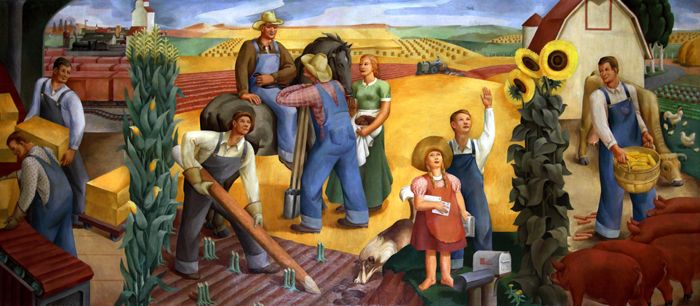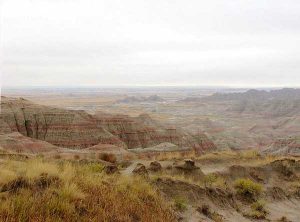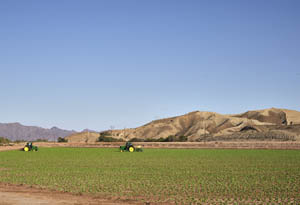By Charles Austin Beard and Mary Ritter Beard, 1921
The Removal of the Indians – Unlike the frontier of New England in colonial days or that of Kentucky later, the advancing lines of home builders in the Far West had little difficulty with warlike natives. Indian attacks were made on the railway construction gangs; General George Custer had his fatal battle with the Sioux in 1876, and there were minor brushes; but they were all of relatively slight consequence. The former practice of treating the Indians as independent nations was abandoned in 1871, and most of them were concentrated in reservations where the government mainly supported them.
The supervision of their affairs was vested in a board of commissioners created in 1869 and instructed to treat them as wards of the nation – a trust which, unfortunately, was often betrayed. A further step in Indian policy was taken in 1887 when the provision was made for issuing lands to individual Indians, thus permitting them to become citizens and settle down among their white neighbors as farmers or cattle raisers. The disappearance of the buffalo, the main food supply of the wild Indians, had made them more tractable and more willing to surrender the freedom of the hunter for the routine of the reservation, ranch, or wheat field.
The Cowboy and Cattle Ranger – Between the frontier of farms and the mountains were plains and semi-arid regions in vast reaches suitable for grazing. As soon as the railways were open into the Missouri Valley, affording an outlet for stock, westward cattle and sheep raising on an immense scale sprang up westward. The far-famed American cowboy was the hero in this scene. Great herds of cattle were bred in Texas; with the advancing spring and summer seasons, they were driven northward across the plains and over the buffalo trails. In a single year, 1884, it is estimated that nearly one million head of cattle were moved out of Texas to the North by 4,000 cowboys, supplied with 30,000 horses and ponies. During the two decades from 1870 to 1890, the cattlemen and the sheep raisers had an almost free run of the plains, using public lands without paying for the privilege and waging war on one another over the possession of ranges. At length, however, both had to go, as the homesteaders and land companies came and fenced in the plain and desert with endless lines of barbed wire. Already in 1893, a writer familiar with the frontier lamented the passing of the picturesque days:
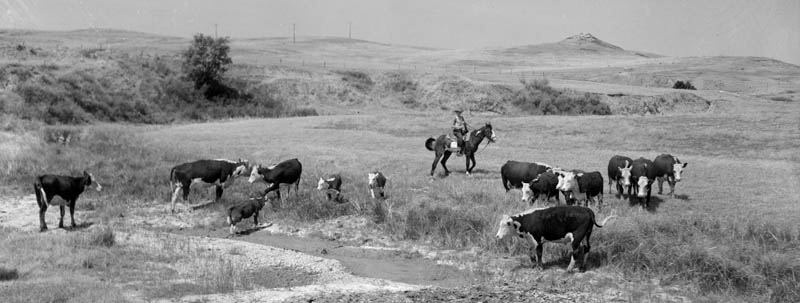
Montana Cattle by Arthur Rothstein, 1936.
“The unique position of the cowboys among the Americans is jeopardized in a thousand ways. Towns are growing up on their pasture lands; irrigation schemes of a dozen sorts threaten to turn bunch-grass scenery into farmland views; farmers are preempting valleys and the sides of waterways; and the day is not far distant when stock-raising must be done mainly in small herds, with winter corrals, and then the cowboy’s days will end.
Even now, his condition disappoints those who knew him only half a dozen years ago. His breed seems to have deteriorated, and his ranks are filling with men who work for wages rather than for the love of the free life and bold companionship that once tempted men into that calling. Splendid Cheyenne saddles are less and less numerous in the outfits; the distinctive hat that made its way up from Mexico may or may not be worn; all the civil authorities in nearly all towns in the grazing country forbid the wearing of side arms; nobody shoots up these towns anymore. The fact is the old simon-pure cowboy days are gone already.”
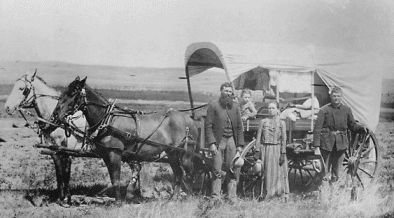
Frontier Homesteaders
Settlement under the Homestead Act of 1862 – Two factors gave a special stimulus to the rapid settlement of Western lands, which swept away the Indians and the cattle rangers. The first was the policy of the railway companies to sell large blocks of land received from the government at low prices to induce immigration. The second was the operation of the Homestead law passed in 1862. This measure practically closed the long controversy over the disposition of the public domain suitable for agriculture. It granted, without any cost save, a small registration fee, public lands in lots of 160 acres each to citizens and aliens who declared their intention of becoming citizens. The one important condition attached was that the settler should occupy the farm for five years before his title was finally confirmed. Even this stipulation was waived in the case of the Civil War veterans, who were allowed to count their term of military service as a part of the five years occupancy required. As the soldiers of the American Revolution and Mexican-American War had advanced in great numbers to the frontier in earlier days, so now veterans led in the settlement of the middle border. Thousands of German, Irish, and Scandinavian immigrants came with them, fresh from the Old World. Between 1867 and 1874, 27,000,000 acres were staked out in quarter-section farms. In 20 years (1860-1880), the population of Nebraska leaped from 28,000 to almost half a million; Kansas from 100,000 to a million; Iowa from 600,000 to 1,600,000; and the Dakotas from 5000 to 140,000.
The Diversity of Western Agriculture – Western agriculture presented many contrasts between the East and South in soil, produce, and management. In the region of arable and watered lands, the typical American unit — the small farm tilled by the owner — appeared as usual. Still, by the side of it, many huge domains were owned by foreign or Eastern companies and tilled by hired labor. Sometimes the great estate became the “bonanza farm” devoted mainly to wheat and corn and cultivated on a large scale by machinery. Again it assumed the form of a cattle ranch embracing tens of thousands of acres.
Again it was a vast holding of diversified interest, such as the Santa Anita ranch near Los Angeles, California, a domain of 60,000 acres “cultivated in a glorious sweep of vineyards and orange and olive orchards, rich sheep and cattle pastures and horse ranches, their life and customs handed down from the Spanish owners of the various ranches which were swept into one estate.”
Irrigation – In one respect, agriculture in the Far West was unique. In a large area spreading through eight states, Montana, Idaho, Wyoming, Utah, Colorado, Nevada, Arizona, New Mexico, and parts of adjoining states, the rainfall was so slight that the ordinary crops to which the American farmer
was accustomed could not be grown at all. Initially baffled, the Mormons studied and mastered it with magnificent irrigation systems. As other settlers poured into the West, the problem of the desert was attacked with a will, some of them replying to the commiseration of Eastern farmers by saying that it was easier to scoop out an irrigation ditch than to cut forests and wrestle with stumps and stones. Private companies bought immense areas at low prices, built irrigation works, and disposed of their lands in small plots. Some ranchers with a water instinct, like the miner for metal, sank wells into the dry sand and were rewarded with gushers that “soused the thirsty desert and turned its good-for-nothing sand into good-for-anything loam.” The federal government came to the aid of the arid regions in 1894 by granting lands to the states to be used for irrigation purposes. In this work, Wyoming took the lead with a law that induced capital ists to invest in irrigation and simultaneously provided for the sale of the redeemed lands to actual settlers. Finally, in 1902, the federal government, by its liberal Reclamation Act, added its strength to that of individuals, companies, and states in conquering “arid America.”
“Nowhere,” writes E. Alexander Powell, a historian of the West, in his picturesque End of the Trail, “has the white man fought a more courageous fight or won a more brilliant victory than in Arizona. His weapons have been the transit and the level, the drill and the dredge, the pick and the spade, and the enemy he has conquered has been the most stubborn of all foes — the hostile forces of Nature… The story of how the white man, within the space of fewer than 30 years, penetrated, explored, and mapped this almost unknown region, of how he carried law, order, and justice into a section that had never had so much as a speaking acquaintance with any one of the three before; of how, realizing the necessity for means of communication, he built highways of steel across this territory from east to west and from north to south; of how undismayed by the savageness of the countenance which the desert turned upon him, he laughed and rolled up his sleeves, and spat upon his hands, and slashed the face of the desert with canals and irrigating ditches, and filled those ditches with water brought from deep in the earth or high in the mountains; and of how, in the conquered and submissive soil, he replaced the aloe with alfalfa, the mesquite with maize, the cactus with cotton, forms one of the most inspiring chapters in our history. It is one of the epics of civilization, this reclamation of the Southwest, and its heroes, thank God, are Americans.
“Other desert regions have been redeemed by irrigation Egypt, for example, and Mesopotamia and parts of Sudan – but the people of all those regions lay stretched out in the shade of a convenient palm, metaphorically speaking, and waited for someone with more energy than themselves to come along and do the work. But the Arizonians, mindful that God, the government, and Carnegie help those who help themselves, spent their days wielding the pick and shovel and their evenings writing letters to Washington with toil-hardened hands.
After a time, the government was prodded into action, and the great dams at Laguna and Roosevelt resulted. Then the people, organizing themselves into cooperative leagues and water-users associations, took up the work of reclamation where the government left off; it is to these energetic, persevere ing men who have drilled wells, plowed fields, and dug ditches through the length and breadth of that great region which stretches from Yuma to Tucson, that the metamorphosis of Arizona is due.”
The effect of irrigation, wherever introduced, was amazing. Stretches of sand and sagebrush gave way to fertile fields bearing wheat, corn, fruits, vegetables, and grass crops. Huge ranches grazed by browsing sheep were broken up into small plots. The cowboy and ranchman vanished. In their place rose the prosperous community – unlike the township of Iowa or the industrial center of the East. Its intensive tillage left little room for hired labor. Its small holdings drew families together in village life rather than dispersing them on the lonely plain. The development of water power in connection with irrigation often afforded electricity for labor-saving devices. It lifted many a burden that, on other days, fell heavily upon the shoulders of the farmer and his family.
By Charles Austin Beard and Mary Ritter Beard; History of the United States, Macmillan, 1921. Compiled and edited by Kathy Alexander/Legends of America, updated March 2023.
Also See:

